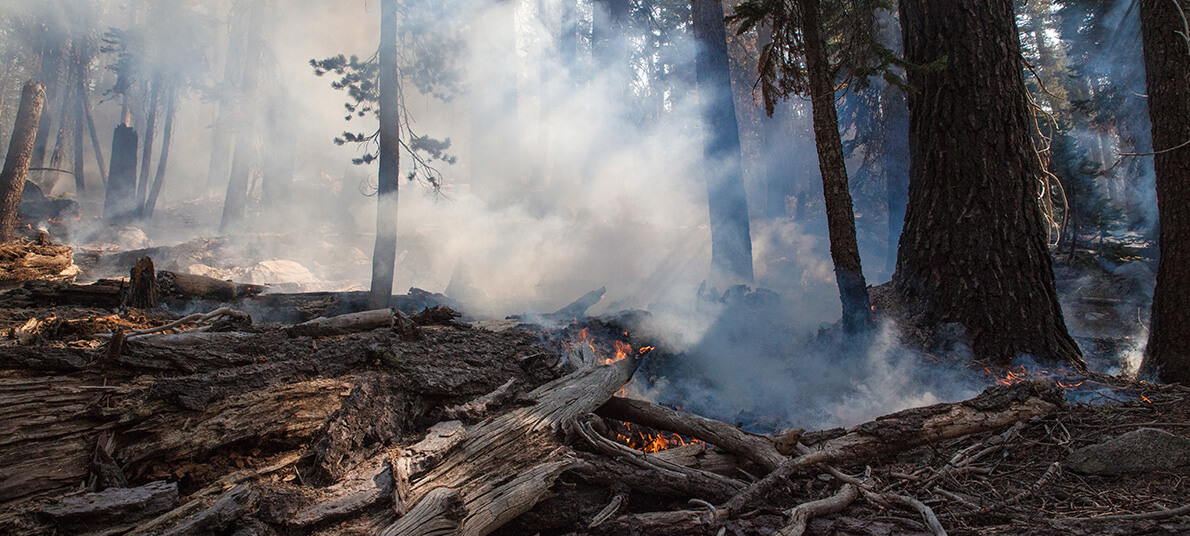Wildfires in the U.S. are becoming more destructive, and it isn’t only the land that suffers — it’s the air.
Fine particulates in the air rose by 55% and black carbon by 86% in the western U.S. between 2010 and 2020, adding 670 premature deaths per year to the toll, according to one study. These pollutants can cause strokes, heart attacks and asthma attacks, and wildfire smoke can cause recurring respiratory illnesses in children.
Conditions will worsen as climate change intensifies. “Climate change, including increased heat, extended drought, and a thirsty atmosphere, has been a key driver in increasing the risk and extent of wildfires in the western United States during the last two decades,” says the National Oceanic and Atmospheric Administration, noting that the drying of organic matter “doubled the number of large fires between 1984 and 2015.”
Global warming exceeded 1.5C for a full year for the first time in the 12 months to February 2024. But how has the land responded? We analyzed wildfire data for 2023 to find the most common causes of wildfires, the states and counties where they are most common and where they’ve increased the most.
The HouseFresh data team analyzed National Interagency Fire Center data to determine the size, number and causes of wildfires across the United States. Looking at figures for 2023, we then ranked the causes of wildfires by number of occurrences. In addition to this, we also ranked states and counties based on total acres of land burned, year-on-year increase in land burned and the average number of acres burned per wildfire.
Key findings
- The biggest human cause of wildfires in the U.S. is debris and open burning, which caused 38.67% of fires in 2023.
- Humans directly caused 72.6% of wildfires in 2023, the second-highest proportion in a decade.
- California is the state with the most burned land in 2023 (344,878 acres).
- Arizona is the state with the largest increase in annual land damage in 2023 (+70,733 acres).
The most common human causes of wildfires in America
Climate change exacerbates the conditions for wildfires. But it is usually a particular human or humans that provide the spark. Humans caused nearly three-quarters (72.6%) of wildfires in 2023. We found that the most common human cause of wildfires is debris and open burning, which is the case in 38.67% of human-caused fires — up from 33.53% in 2022.
‘Debris and open burning’ refers to yard fires, pest control and open trash burning, among other open fires. This category does not include campfires, which come under ‘recreation and ceremony.’ To prevent open fires from spreading, the National Interagency Fire Center (NIFC) says they “must be in small 4 feet by 4 feet piles” and that you should clear “all flammable material and vegetation within 10 feet of the outer edge of pile.” Weather and wind conditions, and local permit requirements, should also be accounted for.
Not only are human wildfires preventable, but they were the main threat to 97% of wildfire-threatened homes between 1992-2015, according to one study. Another found that human-caused fires spread twice as quickly and, since they burn more intensely, kill two to three times more trees in the affected area. So, we looked at how the balance between natural and human-caused wildfires has shifted over the past decade.
We found that the balance between human and natural fires has almost reversed since 2014, although the trend has not been smooth. The proportion of human-caused wildfires grew significantly in 2015, 2016 and 2020, peaking at 77.2% in 2020. This may have been connected to the lockdown period, with more people meeting outdoors or burning trash and renovation waste; the small reduction in human-caused fires since then may be attributed, in part, to education campaigns that arose in the wake of those incidents.
Visualizing the scale of wildfires by state
California suffered the greatest acreage of wildfire destruction in 2023. The amount of damage rose by 29,487 acres to 344,878 acres year-on-year, the fifth largest increase of any state in this period. We found ten states where upwards of 100,000 acres burned in 2023, mostly to the west but also including Texas (168,764 acres) and Oklahoma (152,902 acres).
Drought has been a consistent condition in California across much of the century so far; however, the extreme wet conditions of 2023 and forecasted, in 2024 are not unconditionally good news. Rain is good for wildfire resistance in the short term but encourages the growth of grasses and brush that will become more dangerous when drought returns.
Next, we looked at the overall change in land burned between 2022-23 from state to state. Arizona’s wildfire footprint grew by 70,733 to 218,286 acres, the biggest leap, making it the third hardest-hit state in 2023.
Alaska suffered the second most land damage in 2023, despite the largest annual reduction by acre — down 2,818,744 acres from 3,113,849 in the previous, record-breaking year. “Since the 1970s, summer temperatures in Alaska have risen over four degrees Fahrenheit in regions where wildfire is prevalent,” explains Science Communication Specialist Zav Grabinski. “As the air temperature rises, the air holds more moisture, leading to more convective storms.”
Unfortunately, many places where fires burn are hard to reach; at the same time, permafrost and surface fuels make Alaska’s wildfires particularly pollutive.
Visualizing the scale of wildfires by county
Finally, we looked at which U.S. counties were worst hit and saw the largest increases in 2023. Southeast Fairbanks, Alaska, suffered the largest wildfire footprint in 2023: 141,399 acres, up 115% from 2022. Neighboring Denali was the fifth-worst hit in the U.S. (97,007 acres). In one 24-hour period, the state recorded an incredible 18,600 lightning strikes.
Catron in New Mexico was the second worst-hit county in 2023 despite a 61% reduction in affected acreage from 2022. Most of the county’s 2022 footprint burned in just one wildfire incident: the 325,000-acre Black Fire. The fire was so extreme that despite containing it in July, the Forest Service decided to wait for the next snow — predicted to be November at the earliest — before declaring the fire extinguished.
The biggest increase of any county was for Del Norte, California, whose wildfire footprint rose 11,165 times over from 10 acres in 2022 to 110,534 in 2023. Governor Gavin Newsom declared a state of emergency in August after lightning strikes sparked over two dozen fires and knocked out the entire county’s power.
“We do have a rich fire history, but the intensity we saw this year and the rate of growth was not something we usually deal with,” said Rachel McCain, natural resources director for the Tolowa Dee-ni’ Nation in Del Norte County. “This is definitely the biggest fire we’ve dealt with in about 30 years.” The smoke and poor air from Del Norte’s Smith River Complex fires reached as far as San Francisco.
How bad is wildfire smoke for your health?
Flames and destruction may grab the headlines, but wildfire smoke has devastating effects. Not only does it further compound the very issue — climate change — that contributed to the fire in the first place, but it spreads far from its source and into homes and schools, apparently safe from the primary effects of the fire.
Here are five ways that wildfire smoke can affect your and your loved ones’ health.
| Respiratory illness | Inhaling fine particles irritates your lungs and airways. This can cause coughing or difficulty breathing, and worsen issues such as asthma or chronic obstructive pulmonary disease (COPD). |
| Cardiovascular issues | Particles can get into your bloodstream, triggering inflammation that can lead to heart failure, heart attack or stroke. |
| Developmental damage | Breathing poor air, including wildfire smoke, can slow a baby’s development and increase the risk of asthma. One study suggests that wildfire exposure can cause cell damage to first- and second-trimester placentas. |
| Higher risk of infection | Inhaled particles from wildfire smoke may impact your body’s ability to expel “inhaled foreign materials,” including viruses and bacteria. |
| Impaired cognition | Like traffic pollution, wildfire smoke has been linked with poorer learning outcomes for children, possibly due to changed breathing rates. |
How to protect your home from wildfire smoke
Now that wildfire smoke is an inevitable part of life across much of the country, it pays to prepare your home, maintain supplies and know what to do before the smoke from wildfires spreads close to your neighborhood.

“Your home should be a sanctuary, and it is possible to significantly reduce the impact of wildfire smoke on those inside it. The strategy you can take to protect your home can be summed up in these three steps:
- Seal it up. On bad air days, close all windows and doors and the intake dampers or vents on your air conditioning units.
- Circulate good air. Keep the air fresh and cool by keeping it moving indoors. Set your AC to ‘recirculate’ so as not to suck in bad air from outdoors. Evacuate, if possible, if you can’t keep your home cool.
- Create a “clean room.” Maintain one sealable room free from contaminants such as cigarette smoke and cooking smells. Install an air purifier with a high-efficiency filter, and use this room to sit out the worst episodes.
- Make a DIY air purifier. You can build your own Corsi-Rosenthal Box with a box fan, four HVAC filters (ideally MERV 13), scissors and duct tape.
- Stock up on N95 respirator masks. N95 respirator masks will offer you an extra layer of protection, particularly when you need to go outdoors.
You can read our full guide to protecting your home from wildfire smoke and what to do when a bad air day arises for more details.”
At any moment, you can check the Fire, Weather & Avalanche Center to see where wildfires are burning right now. But preparation is more powerful than response.
METHODOLOGY
To determine the size, number and causes of wildfires across the United States, we reviewed data from the National Interagency Fire Center. The causes of wildfires were ranked based on the number of wildfire incidents in 2023. States and counties were ranked based on total acres of land burned due to wildfire in 2023, the increase in acres of land burned due to wildfire from 2022 to 2023 and the average number of acres burned per wildfire in 2023. Data was collected in January 2024.












